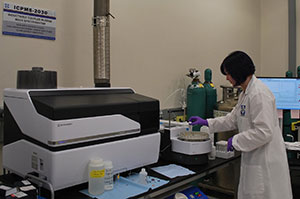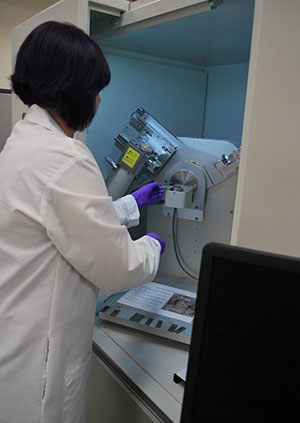
Contact Us
Institutional Communications
Bureau of Mines Building, Room 137
Laramie, WY 82071
Phone: (307) 766-2929
Email: cbaldwin@uwyo.edu
UWs Crystal Luna Receives NSF Graduate Research Fellowship
Published March 30, 2021

Crystal Luna, a first-year master’s student at UW, recently received an NSF Graduate
Research Fellowship, which she will use to study oceanic rocks from Pito Deep and
help develop an interactive exhibit at the UW Geological Museum. Here, she performs
an inductively coupled plasma mass spectrometry analysis at the Shimadzu Center for
Environmental, Forensics and Material Science at the University of Texas-Arlington
during January 2020. (Robert J. Mendoza Photo)
Crystal Luna has come a long way, experiencing a winding path in her pursuit of a college education -- a path that included military service and dropping out of university studies due to financial hardship. Now, that path has led to a point of significant achievement: She has received a National Science Foundation (NSF) Graduate Research Fellowship.
Luna, a first-year University of Wyoming master’s degree student, is studying marine geology and geophysics. She will use her fellowship to study oceanic rocks from Pito Deep, a natural tectonic window at the bottom of the Pacific Ocean located near Easter Island, to understand how oceanic crust forms.
“I have the exciting opportunity to work with the densest in-situ sampling of lower oceanic crust achieved thus far,” she says. “Specifically, I will be analyzing the geochemistry of the minerals within those rocks to gain understanding of the conditions which led to their formation. And, a better understanding of oceanic crust formation contributes to the overarching theory of plate tectonics.”
The NSF Graduate Research Fellowship is one of the nation’s most highly competitive awards for graduate studies. It offers, among other things, three years of financial support (within a five-year period) with an annual $34,000 stipend; a $12,000 cost-of-education allowance; international research and professional development opportunities; and the freedom to conduct research at any accredited U.S. institution of graduate education that recipients choose. For the 2021 competition, NSF received more than 13,000 applications and made 2,074 award offers.
To be in such esteemed company, Luna had to take a nontraditional road in pursuit of a higher education. A native of Richmond, Texas, Luna joined the Army National Guard after high school to serve her country and for the opportunity to garner educational benefits. Unfortunately, things did not go to plan for the first-generation college student at the University of Texas-Arlington.
“I had to suddenly drop out during my junior year due to financial reasons related to unforeseen circumstances with receiving my military benefits,” Luna says. “After that, I attended a community college and worked there to save money while also strengthening my math skills.”
For five years, Luna worked in the Tarrant County College Math Department in Fort Worth, Texas, where she helped students succeed in various math courses. At the same time, she saved money so she could return to the University of Texas-Arlington.
When she was able to go back, Luna adjusted her degree path to geology engineering with a focus in fluid dynamics, and obtained an optional math minor while also engaging in undergraduate research and science communication. She eventually received her bachelor’s degree.
“I think the most important part of this story is to know that, sometimes, unfortunate events happen in your life,” she says. “But, if you remain perseverant and continue to work hard toward your goals, you can overcome obstacles and achieve beyond what you thought was possible.”

Crystal Luna performs an X-ray powder diffraction analysis at the Shimadzu Center
for Environmental, Forensics and Material Science during January 2020. (Robert J.
Mendoza Photo)
Flash forward a few years and Luna, now at UW and armed with her NSF Graduate Research Fellowship, will develop a marine geology exhibit in the UW Geological Museum with the help of Laura Vietti, a UW assistant research scientist and museum collections manager.
Currently, there is not a marine geology exhibit at the museum. Yet, mid-ocean ridges and marine geology are a cornerstone of plate tectonic theory, Luna says. Plans for the exhibit include a virtual interactive experience exploring mid-ocean ridges. That experience will include video footage, animation, acknowledgments of marine scientists from underrepresented groups, and 3D images of hydrothermal vents and outcrops collected during the 2017 Pito Deep expedition.
“I think this is a grand opportunity to share my love of the ocean and knowledge of mid-ocean ridges with the public,” Luna says. “Moreover, the virtual aspect will allow for easier accessibility to those who may not have the opportunity to see it in person.”
Luna credits her academic advisers in the Department of Geology and Geophysics with contributing to her success at UW.
“Michael Cheadle and Barbara John are very encouraging, extremely supportive and are a wealth of knowledge,” Luna says. “They’ve helped me by recognizing and cultivating my potential. They are very communicative and genuine. I am very grateful to have such remarkable advisers.”
John, a UW professor of geology and geophysics, says Luna’s anticipated contributions to marine science, combined with the exhibit for the UW Geological Museum, will allow very broad public engagement in ocean research, a little-known but important aspect of the global Earth system.
“We are very pleased Crystal has joined us for graduate studies at UW, bringing with her experience in mid-ocean ridge studies from her undergraduate work on the Oman ophiolite,” John says of what is considered the largest and most well-preserved subaerial exposure of oceanic crust on Earth and located in the United Arab Emirates. “The NSF Graduate Research Fellowship award is well deserved -- and the icing on the cake for her studies of the unique suite of in-situ samples we collected four years ago.”
“This award is so well deserved, especially for a student, such as Crystal, who is as dedicated to teaching as she is to research,” adds Cheadle, a UW associate professor of geology and geophysics. “The nation needs individuals like Crystal, who have the talent, moral character and passion to become our leading educators in the future.”
Luna adds that the NSF Graduate Research Fellowship provides a key opportunity for her scientific and outreach development.
“It has been my dream to become a professor and a research scientist. I love learning and sharing my knowledge with others,” she says. “Research provides me with the fulfilling challenge I need in life to feel inspired and fruitful. Earning a Ph.D. is my next goal.”
About the NSF Graduate Research Fellowship
The Graduate Research Fellowship Program is a vital part of NSF efforts to foster and promote excellence in U.S. science, technology, engineering and mathematics (STEM) by recognizing talent broadly from across the nation and U.S. territories. The awards are provided to individuals who have demonstrated their potential for significant research achievements.
Former NSF fellows include numerous individuals who have made transformative breakthroughs in science and engineering; have become leaders in their chosen careers; and been honored as Nobel laureates.
Launched in 1952 shortly after Congress established NSF, the Graduate Research Fellowship Program represents the nation’s oldest continuous investment in the U.S. STEM workforce.
Contact Us
Institutional Communications
Bureau of Mines Building, Room 137
Laramie, WY 82071
Phone: (307) 766-2929
Email: cbaldwin@uwyo.edu
